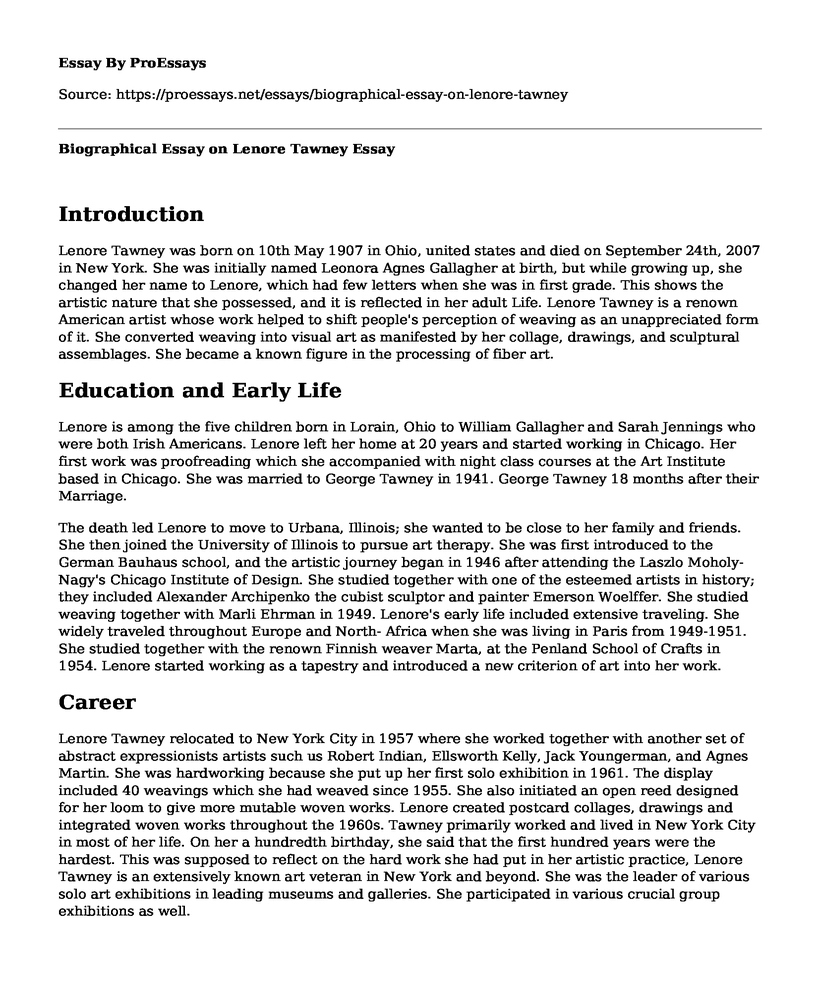Introduction
Lenore Tawney was born on 10th May 1907 in Ohio, united states and died on September 24th, 2007 in New York. She was initially named Leonora Agnes Gallagher at birth, but while growing up, she changed her name to Lenore, which had few letters when she was in first grade. This shows the artistic nature that she possessed, and it is reflected in her adult Life. Lenore Tawney is a renown American artist whose work helped to shift people's perception of weaving as an unappreciated form of it. She converted weaving into visual art as manifested by her collage, drawings, and sculptural assemblages. She became a known figure in the processing of fiber art.
Education and Early Life
Lenore is among the five children born in Lorain, Ohio to William Gallagher and Sarah Jennings who were both Irish Americans. Lenore left her home at 20 years and started working in Chicago. Her first work was proofreading which she accompanied with night class courses at the Art Institute based in Chicago. She was married to George Tawney in 1941. George Tawney 18 months after their Marriage.
The death led Lenore to move to Urbana, Illinois; she wanted to be close to her family and friends. She then joined the University of Illinois to pursue art therapy. She was first introduced to the German Bauhaus school, and the artistic journey began in 1946 after attending the Laszlo Moholy-Nagy's Chicago Institute of Design. She studied together with one of the esteemed artists in history; they included Alexander Archipenko the cubist sculptor and painter Emerson Woelffer. She studied weaving together with Marli Ehrman in 1949. Lenore's early life included extensive traveling. She widely traveled throughout Europe and North- Africa when she was living in Paris from 1949-1951. She studied together with the renown Finnish weaver Marta, at the Penland School of Crafts in 1954. Lenore started working as a tapestry and introduced a new criterion of art into her work.
Career
Lenore Tawney relocated to New York City in 1957 where she worked together with another set of abstract expressionists artists such us Robert Indian, Ellsworth Kelly, Jack Youngerman, and Agnes Martin. She was hardworking because she put up her first solo exhibition in 1961. The display included 40 weavings which she had weaved since 1955. She also initiated an open reed designed for her loom to give more mutable woven works. Lenore created postcard collages, drawings and integrated woven works throughout the 1960s. Tawney primarily worked and lived in New York City in most of her life. On her a hundredth birthday, she said that the first hundred years were the hardest. This was supposed to reflect on the hard work she had put in her artistic practice, Lenore Tawney is an extensively known art veteran in New York and beyond. She was the leader of various solo art exhibitions in leading museums and galleries. She participated in various crucial group exhibitions as well.
Artwork
Tawney shifted to weaving from sculpture art and transformed the ancient creations of a weaver into a new category referred to as fiber art. She followed an intensely experimental path which leads to the production of gauzy tapestries in the 1950s. The transformation included juxtaposition of areas of plain with laid in designs and large thin sections of loose nonfunctional modes of weaving. This results in improvised pieces of art made up of flowing drawings consisting of colorful yarns hanging over the woven forms.
She moved from Chicago to Manhattan in 1961, where she was integrated into the Avant-Garde group of Expressionists. She then began restructuring her tapestries into sculptural weavings. The new weavings were fascinating and included a traditional rectangular form. She transitioned her works from textile traditions to incorporating new forms such as beads, fringes of feathers, shells, and fibers of varying texture and thickness.
Lenore Tawney then assembled all her founded objects and created her first collages and assemblages. She abandoned weaving in !946 and set for non-textile works because they had become her primary focus on art. The pieces were derived from pages out of rare books and manuscript which were age stained. She integrated them with bird's eggs and skeletons, small bones, feathers, pebbles, shells, cocks, and wooden pieces. The little collages display more significant consideration for the aesthetic properties of materials, just like the weavings. However, the miniature collages are more of sentimental quiescent pieces which contain elusive messages. They were used to communicate about the transiency and frailty of life and the essentiality of finding inner peace.
Tawney portrayed attraction to the mystical religious philosophies both from the West and the East. She associated her entire work with in-depth spiritual content. Her art forms and weavings were intended to encourage an attitude of contemplation and communion in life. The extensive global travels provided exposure to a variety of ancient traditions and cultures. Lenore Tawney accepted there is interconnection in all things in life and its entirety. The art of Lenore is seen as an ongoing spiritual attempt to depict the intangible reality.
Cite this page
Biographical Essay on Lenore Tawney. (2022, Dec 05). Retrieved from https://proessays.net/essays/biographical-essay-on-lenore-tawney
If you are the original author of this essay and no longer wish to have it published on the ProEssays website, please click below to request its removal:
- The Shape of Water - Film Analysis Essay
- The Raise of Sharecropping or Peonage - Research Paper
- Essay Sample on Titanic: James Cameron's Epic Love Story
- Erykah Badu's Bag Lady: Analyzing Its Audio & Video Production - Essay Sample
- Celebrating America's Independence: the Fourth of July - Essay Sample
- Essay Example on 9/11: Flaws in Pre-Attack Response and Aftermath
- Free Essay Sample on Media Fear of Crime: Linked Subjects and US Crime Rate







